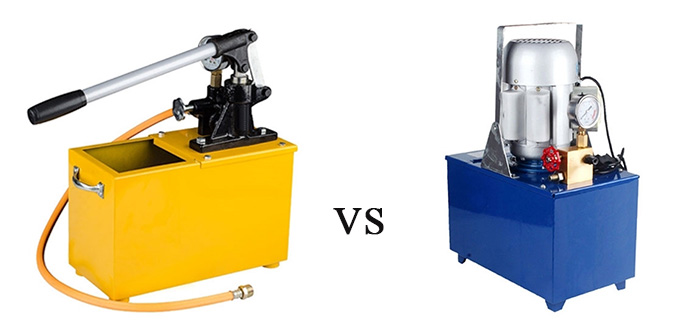Manual vs. Electric Pressure Test Pump
Manual and electric pressure test pumps are essential tools in various industries for testing and calibrating pressure vessels, pipelines, and other systems. Both types serve the common purpose of generating and controlling pressure, but they are different in a variety of ways. In the following, we will explore the key differences between these two pressure test pumps.

Working Principle:
Manual and electric pressure test pumps serve the common purpose of testing the integrity of pressure vessels, pipelines, and other systems. The primary distinction lies in their working principles and the source of power driving the pump.
A manual pressure test pump relies on human effort to generate pressure. It typically features a hand-operated lever or pump mechanism that pressurizes the system by physically pumping the handle. This manual process allows for precise control over pressure increments, making it suitable for applications where a gradual increase in pressure is crucial for testing and detecting leaks. Manual pumps are portable, easy to use, and do not require external power sources.
On the other hand, an electric pressure test pump utilizes an electric motor to pressurize the system. This type of pump is often equipped with an electronic control panel that allows users to set and monitor pressure levels automatically. Electric pumps are advantageous for applications where a constant and controlled pressure needs to be maintained over an extended period.
Efficiency:
Manual pressure test pumps require physical effort to generate pressure. Operated by hand, these pumps are generally slower and less efficient than their electric counterparts. The manual process can be labor-intensive, time-consuming, and prone to variations in pressure due to human factors. Additionally, manual pumps may not provide consistent pressure levels, impacting the accuracy and reliability of the testing process.
Electric test pumps offer enhanced efficiency and precision. Powered by electricity, these pumps automate the pressurization process, ensuring a consistent and controlled pressure level. Electric pumps are faster, require less physical effort, and are capable of handling larger testing projects with greater ease. Their automation reduces the risk of human error, leading to more accurate and reliable test results.
Application:
A manual pressure test pump requires human effort to generate pressure. Typically operated by hand, these pumps are portable and do not rely on external power sources. They are advantageous in situations where electricity is unavailable or impractical, making them suitable for remote locations or field testing.
Electric pressure test pumps are powered by electricity and provide a more automated and controlled testing process. These pumps are capable of generating higher pressures with greater accuracy, making them suitable for demanding applications or large-scale testing requirements. Electric pumps are efficient and can maintain a constant pressure, ensuring more reliable and repeatable results. However, they may be less versatile in remote locations where power sources are limited or unavailable.
The choice between a manual and electric pressure test pump depends on the specific application requirements. Manual pumps are suitable for simpler, occasional testing in remote areas, while electric pumps are preferable for precise, high-pressure testing in more controlled environments.
Cost:
Manual pressure test pumps are generally more affordable upfront, as they don't require electric components. However, they demand physical effort to operate, which can be time-consuming and less efficient. Electric pressure test pumps are more expensive due to their motorized components, but they offer the advantage of automated operation, requiring less manual labor and ensuring consistent pressure levels. The cost difference reflects the trade-off between initial investment and operational convenience.
The choice between manual and electric pressure test pumps depends on the specific requirements of the application. While manual pumps may be more portable and cost-effective upfront, electric pumps offer superior efficiency, precision, and automation. The decision should consider factors such as the scale of testing, required precision, labor considerations, and the availability of power sources. As technology advances, electric pressure test pumps continue to evolve, offering more features, improved portability, and enhanced user control. Ultimately, selecting the right pump depends on balancing the advantages and limitations based on the unique needs of each testing scenario. Both types of pressure test pumps are available in ATO store.

